Yellowstone National Park Destination Guide
This essential guide will help you prepare for an unforgettable journey through America's first national park.
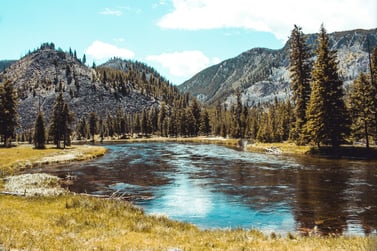
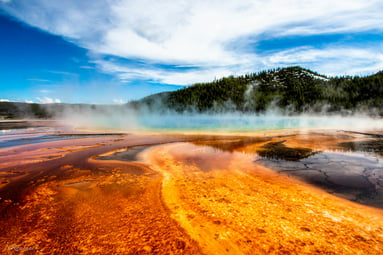
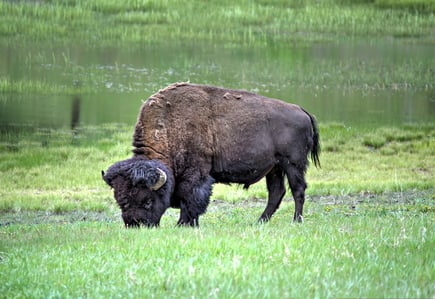
Essential Camping Information for Yellowstone National Park
Everything you need to know before your Yellowstone camping adventure
Connectivity & Services
- Cell Service: Very limited throughout the park. Best near visitor centers and developed areas.
- WiFi: Available at some lodges and visitor centers for a fee.
- Emergency Communication: Ranger stations have landlines and radios.
Seasonal Considerations
- Summer (June-August): Peak season with all facilities open. Warm days, cool nights.
- Fall (September-October): Lower crowds, cooler weather, possible snow at higher elevations.
- Winter (November-April): Most roads closed to regular vehicles. Snowmobile or snowcoach access only.
- Spring (May): Unpredictable weather, limited facilities, roads gradually opening.
Weather Conditions
- Summer Temperatures: Days 70-80°F (21-27°C), nights 30-40°F (0-4°C).
- Elevation Effect: Yellowstone sits at 6,500-8,000 feet elevation. Temperatures vary widely.
- Afternoon Storms: Thunderstorms common in summer afternoons.
- Weather Changes: Conditions can change rapidly. Be prepared for all weather scenarios.
Emergency Information
- Emergency Number: 911 (works in areas with cell service)
- Park Emergency Line: 307-344-7381
- Medical Services: Clinics at Mammoth Hot Springs, Old Faithful, and Lake areas (summer only)
- Ranger Stations: Located throughout the park for assistance
Camping Experience Details for Yellowstone
Important information about what to expect during your camping adventure
Participatory Camping
This is a participatory camping trip, where all travelers will assist in setting up camp and cooking meals. Guides will teach you the best methods for quick set up and take down of tents and will lead the cooking, providing clear instructions and oversight.
If you've never set up camp or cooked outdoors before, this is the perfect opportunity to learn under expert supervision!
Frequently Asked Questions
Travel Safety & Insurance
Check out the National Park Service's website for the most up-to-date information on safety while traveling.
We recommend that all travelers have travel protection. Visit our page here for more information.
Provided Equipment
All your camping equipment (other than a sleeping bag and pillow) will be included. This includes tents, chairs, sleeping pads, stove, canopy, lanterns, and all cooking equipment (pots, pans, dishes, etc).
Tents will be 4-person camping tents, double occupancy. You'll use inflatable camping pads on the ground beneath your sleeping bags.
Connectivity & Charging
WiFi and cell service are usually nonexistent or very limited at the campgrounds. Some campgrounds may offer free WiFi, although it may be unreliable.
There will be limited outlets around showers to charge devices, but power banks are recommended.
Facilities & Amenities
Not all campsites have shower facilities. If that is the case, your Guide will take the group to a place to shower. Please have cash or spare change on hand as you may need to purchase shower tokens.
At the specific Yellowstone Park/Mountainside KOA there are free showers and bathroom facilities with unlimited use. They aren't too far from the tent sites.
Mosquito Preparation
Tight-weave cotton shirts and pants work better than more porous synthetics. Wear khaki or other neutral colors.
Mosquitoes are attracted to dark colors, especially blue. Stay away from scented soaps, lotions and shampoos.
Food & Snacks
Lunches usually consist of packed sandwiches, granola bars, chips, trail mix, etc., which can also serve as snacks throughout the trip.
Vegan options include vegan burgers/sausages, pasta with mushrooms and nuts for added protein, and vegan cheese alternatives.
Guides will stop at a grocery store for travelers to pick up snacks/essentials.
Wildlife Safety
Bear spray can be rented if travelers are concerned when hiking. Guides should have a can of bear spray.
As long as you're hiking in a group, the chance of needing to use bear spray is very small.
There are places to refill water bottles in certain areas inside the park, typically at Visitor Centers. Hydration bladders are not necessary, but a couple of larger water bottles are recommended.
Flights
Need help searching for a flight? We recommend Skyscanner.com to compare different routes and rates. Click here to search!
Camping Checklist
Use this checklist to ensure you pack everything you need for your Yellowstone camping adventure
Clothing & Personal Items
- Moisture-wicking base layers
- Insulating mid layers (fleece or wool)
- Waterproof/windproof outer layer
- Hiking boots or sturdy shoes
- Camp shoes or sandals
- Hat with brim for sun protection
- Warm hat and gloves (even in summer)
- Extra socks and underwear
- Bandanas or buffs
- Sleepwear
- Camera and charger/extra batteries
- Water bottle
- Sleeping bag and pillow
- Daily toiletries (deodorant, toothbrush and toothpaste, etc.)
- Towel
Health & Safety
- First aid kit with basic medications
- Sunscreen and lip balm with SPF
- Insect repellent
- Bear spray (available for purchase in the park)
- Hand sanitizer
- Biodegradable wet wipes
- Personal medications
- Water treatment method (filter, tablets, or boiler)
- Emergency whistle
- Physical map of Yellowstone (cell service is limited)
- Flashlight or headlamp
Camping Tips
- Always store food, cooking gear, and scented items in bear-proof containers or lockers provided at campgrounds.
- Pack layers, as temperatures can vary dramatically between day and night.
- Bring cash for campgrounds that don't accept credit cards.
Must-See Areas in Yellowstone
Discover the incredible places you'll want to visit during your Yellowstone camping adventure
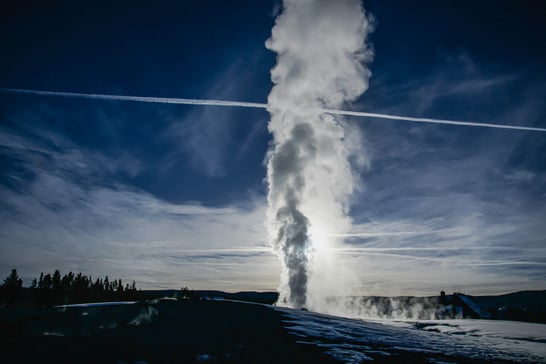
Old Faithful & Upper Geyser Basin
Home to the world-famous Old Faithful geyser and the largest concentration of geothermal features in the world.
Don't Miss:
- Old Faithful Geyser – Erupts approximately every 90 minutes.
- Morning Glory Pool – Stunning rainbow-colored hot spring.
- Grand Prismatic Overlook – Perfect spot for photographs.
- Biscuit Basin – Features the stunning Sapphire Pool.
Lamar Valley
Known as "America's Serengeti," this open valley offers the best wildlife viewing in the park.
Wildlife Viewing:
- Wolf Packs – Best viewed at dawn and dusk.
- Bison Herds – Often visible throughout the day.
- Grizzly Bears – Most active in morning and evening.
- Elk and Pronghorn – Frequently spotted grazing.
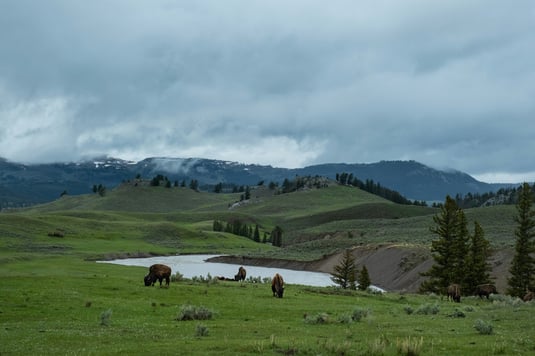
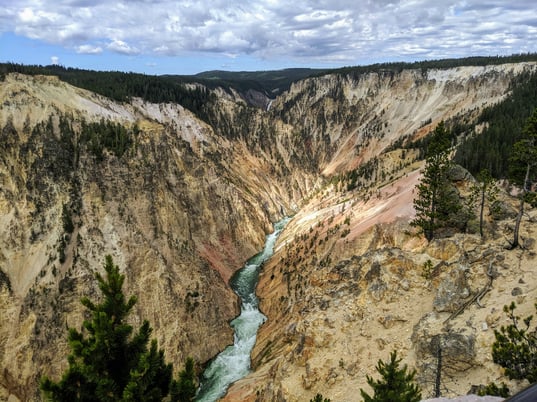
Grand Canyon of Yellowstone
A dramatic canyon with colorful rock walls and two magnificent waterfalls.
Best Viewpoints:
- Artist Point – Classic view of the Lower Falls.
- Lookout Point – Direct view of the 308-foot Lower Falls.
- Upper Falls View – See the 109-foot Upper Falls.
- North Rim Trail – Less crowded hiking trail with stunning views.
Camping Food Ideas
Proper meal planning is essential for an enjoyable camping experience. Here are some easy and delicious options for your Yellowstone adventure:
Campfire Foil Packets
Combine protein, vegetables, and seasonings in foil for an easy meal cooked over the fire.
One-Pot Pasta
Cook pasta with sauce ingredients in a single pot for minimal cleanup.
Camp Breakfast Skillet
Eggs, potatoes, and veggies in a cast iron skillet for a hearty start.
Wraps & Sandwiches
Easy lunch options that require no cooking during busy days exploring.
No-Cook Overnight Oats
Prepare breakfast the night before with oats, milk, and toppings.
Dutch Oven Chili
Perfect comfort food after a day of hiking; can be made ahead and reheated.
Safety & Conservation
Tips for staying safe and minimizing your impact on Yellowstone's fragile ecosystem
Wildlife Safety
- Distance Rules: Stay at least 100 yards (91 m) from bears and wolves, and 25 yards (23 m) from all other wildlife.
- Bear Safety: Carry bear spray and know how to use it. Make noise while hiking to avoid surprising bears.
- Food Storage: Store all food, trash, and scented items in bear-proof containers or lockers.
- Wildlife Viewing: Always use binoculars or telephoto lenses - never approach wildlife for photos.
- Bison Awareness: Despite their docile appearance, bison are unpredictable and dangerous. Give them plenty of space.
Leave No Trace Principles
- Pack It In, Pack It Out: Carry out all trash, leftover food, and litter.
- Stay on Boardwalks: Thermal areas have thin, fragile surfaces that can break under your weight.
- Respect Water Sources: Camp at least 200 feet from lakes and streams. Use biodegradable soap.
- Minimize Campfire Impact: Use established fire rings and fully extinguish fires.
- Leave What You Find: Do not take rocks, plants, antlers, or other natural objects from the park.
⚠️ Important Thermal Area Safety
Yellowstone's geothermal features are as dangerous as they are beautiful. The ground around thermal features is fragile and thin with scalding water just below. Every year, visitors are severely burned when they fall through the crust. Stay on boardwalks and designated trails at all times.
Essential Camping Tips
- Elevation Awareness: Yellowstone sits at high elevation. Stay hydrated and take it easy on your first day.
- Weather Preparedness: Pack for all conditions, as weather can change rapidly at any time of year.
- Night Sky Viewing: Yellowstone offers exceptional stargazing opportunities. Bring a star chart or app.
- Quiet Hours: Respect quiet hours (typically 10 PM to 6 AM) in all campgrounds.
Tipping
Tips for Guides, drivers and restaurants are not included. Tips provide supplemental income, and, while not mandatory, are greatly appreciated. If the local teams have added to the experience, please reward them.
Your Guide will also often be your driver throughout your trip. In this case we recommend tipping the combined amount ($20-30) per person/per day.
| Guides | USD $10-15 per person/per day | |
| Drivers | USD $10-15 per person/per day |
